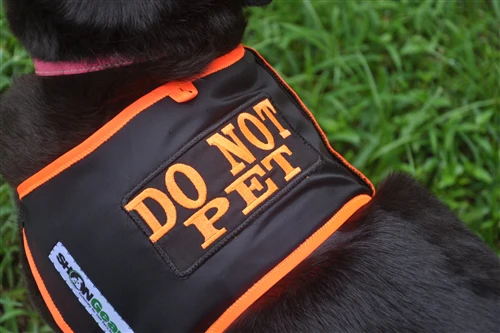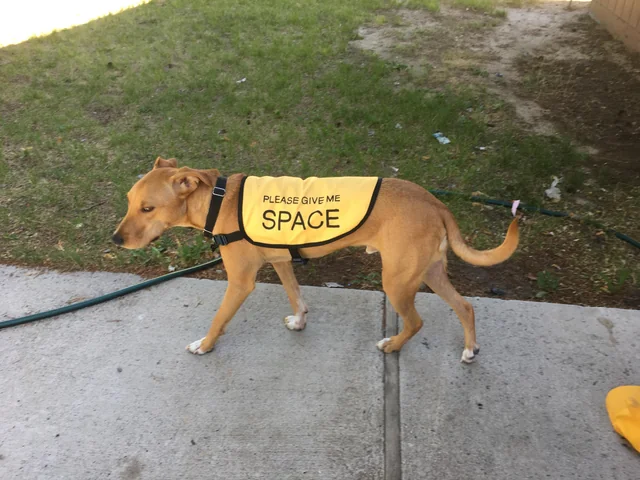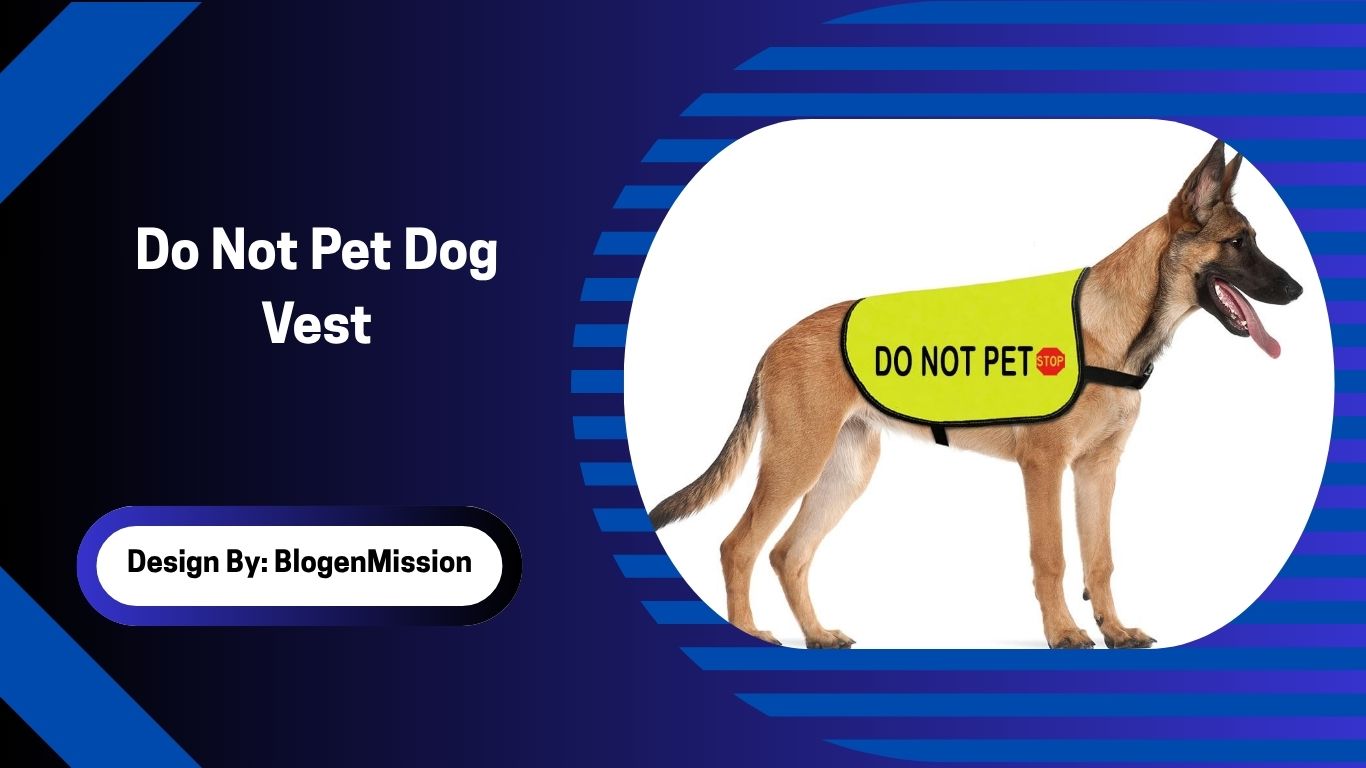A “Do Not Pet” dog vest ($10–$100) helps service dogs, training dogs, or anxious pets stay safe by signaling boundaries, reducing stress, and ensuring focus in public spaces.
For many dog owners, ensuring their pet’s comfort and safety in public is a top priority. A “Do Not Pet” dog vest is a simple yet effective tool to communicate that your dog needs space. Whether your dog is a service animal, in training, or simply uncomfortable with strangers, these vests help set boundaries.
This comprehensive guide explores the benefits, features, and considerations of using a “Do Not Pet” dog vest, along with tips for choosing the right one and understanding legal aspects.
What Is a “Do Not Pet” Dog Vest?
A “Do Not Pet” dog vest is a wearable garment for dogs, typically made of durable fabric, with clear text or patches that read “Do Not Pet,” “Working Dog,” or similar phrases. These vests signal to others that the dog should not be approached or touched, helping to prevent unwanted interactions. They are commonly used for service dogs, therapy dogs, or pets with anxiety, reactivity, or training needs.
Why Use a “Do Not Pet” Dog Vest?

There are several reasons pet owners choose these vests, each addressing specific needs for both the dog and the owner.
Protecting Service Dogs
Service dogs, trained to assist individuals with disabilities, require focus to perform tasks like guiding or alerting. A “Do Not Pet” vest ensures they remain undistracted, maintaining their handler’s safety. For example, a guide dog for a visually impaired person needs uninterrupted concentration.
Supporting Dogs in Training
Dogs in training, such as those learning to become service or therapy animals, benefit from reduced distractions. A vest helps reinforce their focus, aiding trainers in achieving consistent results.
Managing Anxiety or Reactivity
Some dogs are nervous or reactive around strangers or other animals. A vest communicates their need for space, reducing stress and preventing potential incidents, like barking or lunging.
Ensuring Safety in Public Spaces
In crowded places like parks or stores, a vest can prevent unsolicited petting, keeping both the dog and the public safe. It’s especially useful for breeds perceived as intimidating, like German Shepherds or Rottweilers.
Benefits of a “Do Not Pet” Dog Vest
Using a “Do Not Pet” vest offers multiple advantages for dogs and their owners.
Clear Communication
The bold, visible text on the vest sends an unmistakable message to passersby, reducing the likelihood of unwanted interactions without the owner needing to intervene repeatedly.
Enhanced Dog Comfort
By minimizing unexpected touches or approaches, the vest helps anxious or sensitive dogs feel more secure, improving their behavior and confidence in public.
Professional Appearance
For service or working dogs, a vest gives a professional look, reinforcing their role and discouraging casual petting attempts.
Customizable Options
Many vests allow for custom patches, such as “In Training” or “Medical Alert Dog,” tailoring the message to your dog’s specific needs.
Features to Look for in a “Do Not Pet” Dog Vest
Choosing the right vest involves considering design, comfort, and functionality. Here are key features to prioritize:
Durable Materials
Look for vests made of sturdy, weather-resistant materials like nylon or polyester, which withstand outdoor conditions and frequent use.
High-Visibility Text
Ensure the “Do Not Pet” message is in bold, large font, often in bright colors like red or yellow, for maximum visibility. Reflective strips enhance safety during low-light conditions.
Adjustable Fit
Vests should have adjustable straps to fit your dog comfortably, accommodating breeds from small Chihuahuas to large Great Danes. Check sizing charts for chest and girth measurements.
Breathable and Lightweight Design
Opt for breathable fabrics to prevent overheating, especially for active dogs or those in warm climates. Lightweight designs ensure comfort during extended wear.
Additional Features
Some vests include pockets for carrying essentials, leash attachment points, or handles for better control, particularly useful for service dog handlers.
Costs of “Do Not Pet” Dog Vests
The cost of a “Do Not Pet” dog vest varies based on quality, features, and customization. Here’s a breakdown of average prices:
| Vest Type | Average Cost | Features |
| Basic Vest | $10–$25 | Simple design, single patch, adjustable. |
| High-Visibility Vest | $25–$50 | Reflective strips, bold text, durable. |
| Custom Service Dog Vest | $50–$100 | Custom patches, handles, premium materials. |
| Eco-Friendly Vest | $30–$75 | Biodegradable or recycled materials. |
Regional Price Variations:
- Urban Areas (e.g., NYC, LA): Higher costs ($30–$100) due to demand and specialty retailers.
- Online Retailers: More affordable ($10–$50), with options like Amazon or Etsy offering customization.
- Pet Stores: Mid-range ($20–$60), often with immediate availability.
Also Read: What To Do With A Dead Pet – Compassionate Guide!
Legal Considerations for “Do Not Pet” Vests
While vests are helpful, they don’t grant legal status. Be aware of regulations surrounding service dogs and vests:
Service Dog Laws
In the U.S., the Americans with Disabilities Act (ADA) allows service dogs in public spaces but doesn’t require vests. Misrepresenting a pet as a service dog is illegal in many states, with fines up to $1 Ascertain whether a dog is a service animal or not.
Local Regulations
Some states, like California and Florida, have specific laws against misrepresenting pets as service dogs, with penalties including fines or jail time. Always ensure your dog qualifies as a service animal before using service dog-specific vests.
Vest Usage
A “Do Not Pet” vest doesn’t legally designate a dog as a service animal but helps communicate boundaries. For non-service dogs, ensure the vest’s message aligns with their behavior or training needs.
How to Choose the Right “Do Not Pet” Vest?
Selecting the perfect vest involves balancing your dog’s needs with practical considerations:
Assess Your Dog’s Needs
Determine why your dog needs the vest—service work, training, or behavioral issues—to choose appropriate messaging (e.g., “Do Not Pet” vs. “In Training”).
Measure Your Dog
Use a measuring tape to get accurate chest and girth measurements. Most retailers provide sizing guides to ensure a snug, comfortable fit.
Read Reviews
Check customer reviews on platforms like Amazon or Chewy for insights on durability, comfort, and effectiveness. Look for vests with high ratings (4+ stars).
Consider Customization
For unique needs, opt for customizable vests from sites like Etsy, where you can add specific patches or embroidery.
Training Your Dog to Wear a Vest
Introducing a vest requires patience to ensure your dog is comfortable:
- Start Slowly: Let your dog sniff and explore the vest before putting it on.
- Use Positive Reinforcement: Reward with treats or praise when they wear it calmly.
- Gradual Wear Time: Increase wearing time gradually, starting with short sessions at home.
- Monitor Comfort: Ensure the vest isn’t too tight or causing irritation.
Where to Buy a “Do Not Pet” Dog Vest?
- Online Retailers: Amazon, Chewy, and Etsy offer a wide range of vests, from budget-friendly to custom designs.
- Pet Specialty Stores: Petco and PetSmart stock vests, often with in-store fitting options.
- Local Makers: Check for local pet boutiques or trainers offering custom vests.
- Service Dog Organizations: Groups like Canine Companions may provide vests for certified service dogs.
Alternatives to “Do Not Pet” Vests

If a vest isn’t suitable, consider these alternatives:
- Collars or Leashes with Tags: “Do Not Pet” tags or bands ($5–$20) are less intrusive but still effective.
- Bandanas: Lightweight and customizable ($10–$30), ideal for smaller dogs.
- Verbal Commands: Train your dog to respond to commands like “leave it” to manage interactions, paired with owner advocacy.
Emotional and Practical Benefits
Using a “Do Not Pet” vest not only protects your dog but also reduces your stress as an owner. It minimizes the need to constantly explain your dog’s needs, allowing you to focus on their well-being and training. For service dog handlers, it reinforces the dog’s role, fostering respect from the public.
Tips for Maximizing Effectiveness
- Pair with Training: Reinforce the vest’s message with consistent training to manage your dog’s behavior.
- Educate the Public: Politely explain the vest’s purpose if approached, fostering understanding.
- Maintain Visibility: Keep the vest clean and ensure text remains legible.
- Combine with Other Signals: Use a leash wrap or collar tag for added clarity.
Why a “Do Not Pet” Vest Matters?
A “Do Not Pet” dog vest is more than a piece of gear—it’s a tool for creating a safer, less stressful environment for your dog. By clearly communicating boundaries, it supports your dog’s training, comfort, and safety while giving you peace of mind in public spaces. Whether your dog is a working service animal or a pet needing space, this vest is a small investment with big impact.
FAQs:
1. Why do some dogs need a “Do Not Pet” vest?
Dogs like service animals, those in training, or with anxiety need vests to avoid distractions or stress from unwanted petting, ensuring safety and focus in public spaces.
2. Are “Do Not Pet” vests legally required for service dogs?
No, the ADA doesn’t require vests for service dogs, but they help communicate boundaries. Misrepresenting a pet as a service dog using a vest can violate state laws.
3. How do I train my dog to wear a “Do Not Pet” vest?
Introduce the vest gradually, using treats for positive reinforcement. Start with short sessions at home, ensuring a comfortable fit, and slowly increase wear time in public settings.
4. Can I customize a “Do Not Pet” vest for my dog?
Yes, many retailers like Etsy offer customizable vests with patches like “In Training” or “Medical Alert.” Costs range from $25–$100, depending on materials and design.
5. What are eco-friendly “Do Not Pet” vest options?
Eco-friendly vests, made from recycled or biodegradable materials, cost $30–$75. They’re durable, sustainable, and ideal for environmentally conscious owners seeking high-visibility “Do Not Pet” messaging.
Conclusion:
A “Do Not Pet” dog vest, priced $10–$100, ensures safety and comfort for service dogs, training dogs, or anxious pets by setting clear boundaries in public. With durable, adjustable, and customizable designs, these vests reduce stress and enhance focus. By choosing the right vest and pairing it with training, you can protect your dog’s well-being while navigating public spaces with confidence, making it a valuable tool for any pet owner prioritizing safety.
